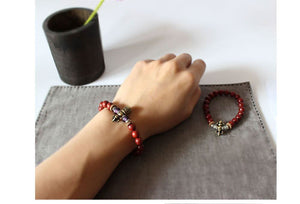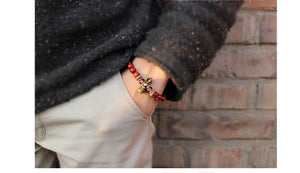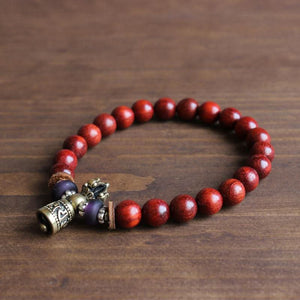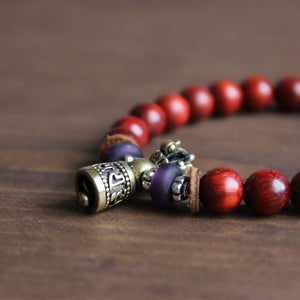Your Cart is Empty
Free Global Shipping + Easy Returns

















Description: This is a handmade bead bracelet imported from Nepal. At the core is the hand carved copper Vajra and bell.
In Vajrayana it is most commonly known as the Vajra ritual scepter and matching bell. In Mahayana the term vajra relates to states of meditation known as samadhi along with bodhisattva practices such as are described in the Vajracchedika Sutra. It is a prominent symbol of wisdom and enlightenment.
Specifications:
Item Type: Bracelets
Bracelets Type: Strand Bracelets
Style: Vintage
Material: Wood beads, Cowhide spacers, Pure Sanders Copper, Grape Lampwork spacers
Chain Type: Beaded Bracelet
Function: Meditation
Clasp Type: Stretch Bracelet
Theme: Vajra
Main beads size: 8mm
Natural Bracelet: Artisan Handmde
Package: Eco envelope
Materials Used:


Vajra Scepter: As a Buddhist scepter in Vajrayana Buddhism it is a small object, generally made of metal, having five or nine prongs at each end that bend inward to form a rounded enclosure. When the vajra scepter is held in the upraised right hand of the deity Vajrapani, in wrathful form, the vajra is understood to be a weapon, like a lightening bolt in the hands of Zeus and Indra, or the club of Heracles - the divine hero of Greek Mythology. It is a throwing weapon intended to stun the victim who is the target after which they are bound with the vajra lasso that is held in the left hand of Vajrapani. As a physical ritual object the vajra is almost always accompanied by a bell with a half vajra handle (Sanskrit: ghanta).
Buddhist Meanings of the Term Vajra: The term vajra is found in early Pali style Buddhism and the later Mahayana Buddhism. In Vajrayana it is most commonly known as the vajra ritual scepter and matching bell. In Mahayana the term vajra relates to states of meditation known as samadhi along with bodhisattva practices such as are described in the Vajracchedika Sutra. In Buddhism as a whole vajra refers to (1) a geographic location - Vajrasana, (2) a body posture - vajra asana, and to (3) a concentrated mental state - vajra samadhi.
In the Vajrayana Buddhism of the Himalayas and Tibet the term vajra (Tibetan: dorje) is commonly attached to the names of subjugated local deities, mountain gods or anything of the sort that is not of Indian Tantric origin. Examples are the worldly Tibetan deities Dorje Setrab, Dorje Legpa, Dorje Yudronma, Dorje Shugden and others.